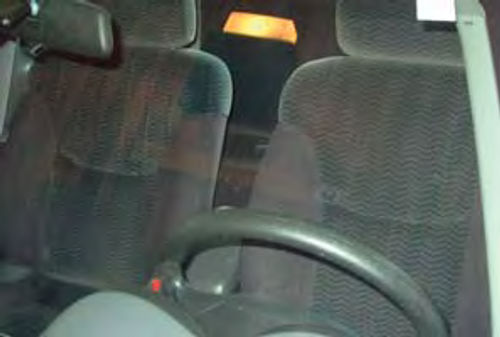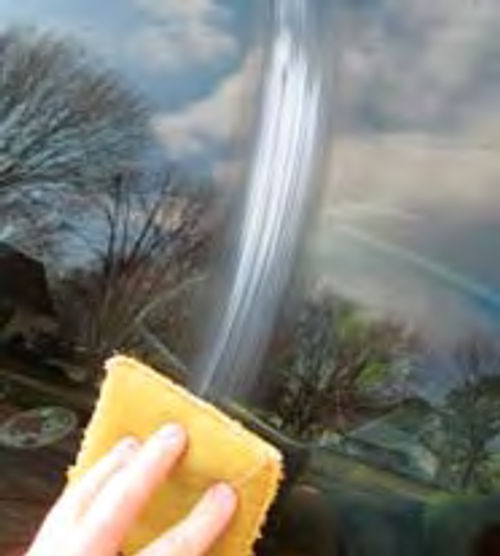Automotive Glass Care

Sparkling Windows Look Great and Are a Safety Factor as Well. Here Are the Products & Techniques You Need.
CLEANING AUTOMOTIVE Glass can be tricky—there are traps and pitfalls in the quest for “invisible” glass. Clean glass may not get a vehicle noticed, but having dirty glass certainly will detract from your vehicle’s complete, clean look. No one will see your polished paint when your glass has spots, dirt and general grime. The added benefit to clean glass is safety—detailing glass is one of the few jobs where beauty and safety merge, so having the right products and strategy is paramount.
Keep in mind that caring for automotive glass is a prime source of wives’ tales and secret methods—ask 10 people how to clean a windshield, and you’ll get all kinds of “secrets.” I’ve seen windshields cleaned with newspapers and bottled water, with old T-shirts and Windex, or a bucket of Dawn degreasing soap and a chamois.
What Not To Use
The first issue we’ll address involves products and chemicals. What not to use is just as important as what works the best. Far too many casual detailers like to multi-task and use Windex—or other household glass cleaners—on their vehicles. This is perhaps the greatest no-no in cleaning automotive glass. Using ammonia-based cleaners on the interior glass releases harmful fumes that shouldn’t be ingested in closed areas. Both inside and outside, ammonia is harmful to vinyl, leather, rubber and plastic, aging and damaging these materials significantly. Also, if you have tinted windows, ammonia-based cleaners can be destructive and ruin your tinting.
Use an ammonia-free, automobile-specific glass cleaner—it’s a tip that can save damage to your vehicle.
Now, let’s populate your glass-cleaning arsenal with great products before we go step-by-step through the detailing process.
Use These For Best Results
After sampling dozens of glass-cleaning products over the years, nothing has matched the versatility and effectiveness of Stoner’s Invisible Glass. This cleaner lives up to its product name, offering fantastic results quickly. Happily, this product is becoming increasingly available at automotive stores and even local department stores, so it shouldn’t be a difficult find. If you have a choice, get the product in the aerosol can instead of the spray version—the aerosol version has a foaming, grime-cutting action that the spray bottle version doesn’t replicate.
A quality glass polish is another tool in the arsenal. Autoglym and Sonus make excellent glass polishes, and both double as chrome polishes as well. Glass polish is strong and goes on like wax, forming a paste on the glass. When wiped away, the results are streak-free and crystal clear. The strong cleaning agents in a glass polish work best on the toughest glass stains. Water is the most frequent windshield offender—whenever a drop of water dries on automotive glass, it leaves mineral deposits behind that are difficult to fully remove.
Checking your glass at a reflective angle will reveal any water spots, as well as bird and bug etchings, that have scarred your glass. Polishes dissolve these stains, as well as other tough stains that regular cleaning can’t remove. Additionally, polishes achieve a streak-free finish because they are wiped away after drying.
Microfiber Applicators
For the application of polishes, use a microfiber applicator or wax applicator.
The best tool for wiping away glass polishes, as well as cleaning glass in general, is a tight, waffle-weave, microfiber detailing cloth.
There are many varieties of detailing towels, but again, Sonus is the brand I’ve found to be the most durable and effective. Nothing against newspapers and old T-shirts, which are better than paper towels, but microfiber polishing towels can be reused and have a waffle-weave, which offers a “scrubbing” element that the alternatives do not have, adding to microfiber’s effectiveness.
Cleaning Techniques
Now, for the “how-to” of cleaning automotive glass. The first step is to clean everything else, if you’re doing a full detail or restoration job. Glass almost rhymes with last, and for good reason— the surface and location of automotive glass makes it susceptible for recontamination with other products. For instance, an interior windshield will often catch overspray or hand smearing while you clean a dashboard.
So, glass is last.
Glass should also be done in the shade. Evaporation of water and products can be problematic for your results. Your chances for streak-free success are heightened when working in a cool, shaded area.
For moderate cleaning of exterior glass, mist your cleaning product directly on the glass, saturating the bug, dropping and water stains. Use a polishing cloth with a waffle weave (which, as stated earlier, adds a scrubbing element), and work the product in until the stains are gone and the product dissipates. Repeat with a lighter misting and a dry, clean side of the towel. This approach should work for most automotive glass contamination.
For more difficult stains, reach for your glass polish. This can be applied by hand with a wax applicator, but if you have one available, use a random action polisher with a soft pad. No need for significant pressure—let the pad do the work. Simply work in the polish until it starts dusting, then wipe away with a polishing towel. If applying by hand, use a microfiber applicator and let the polish dry, thus dissolving all the contaminants. Mist and wipe with your standard cleaner to remove excessive dust and film.
Don’t be afraid to use multiple applications of polish or cleaners to achieve the appropriate results. In many cases, once your glass is clean a final mist and wipe with Invisible Glass will be the finishing touch.
If you have detailing clay at your disposal, don’t throw it away when it has exhausted its use on your paint—old detailing clay chunks make great glass cleaners. Use them during the wash phase of your detail job, lubricating a wafer-shaped piece of clay with soapy water. The glass will almost assuredly be clean and contamination-free, and ready for a final mist and wipe without the need for elbow grease and multiple product applications.
For those of you who are fans of sealants such as Rain-X, gauge how your windshield performs when cleaned properly. I have experienced Rain-X-like results without the use of a sealant by simply maintaining clean, polished glass. With no contaminants to “cling” to, the water sheets right off with the pressure of the wind generated at driving speeds. Rain-X basically forms a sealed layer over those contaminants, and I have found that sealant-treated glass is difficult to get perfectly clean or streak-free.

Going Inside the Vehicle
When doing interior glass, be sure to roll down your side windows a few inches and clean the tops of them first— there is a border of film that builds up where the window shuts, and cleaning that area first will assure that when you roll your window down, you don’t have that crown of gunk at the top of each window. And perhaps the greatest complaint for interior glass is the angled windshields and rear windshields—folks simply can’t seem to access those areas to rub them down with cleaner without being a fully stretched contortionist. If you’re using a cleaning product such as Invisible Glass, dampen the towel and put the towel on the back of your hand—this technique helps you get into the nooks of angled glass better. Turn the towel over for the finishing wipe.
Even then, you’ll likely be incapable of achieving a streak-free finish on the interior due to the constraints of working with the glass. This is when your glass polish will be quite handy. The polish requires application and removal, with little elbow grease involved. Use the “backhand” method to put a thin film over your hard-to-reach interior glass, then use a dry polishing cloth to perform removal—presto, a streak-free interior finish. For smokers, this is a must as the glass polish easily dissolves the film that builds up on interior glass. Even if you’re a non-smoker, you’ll notice that film builds up inside, regardless. This film occurs because of the gradual decomposition of your upholstery, foam, and other interior elements. Coincidentally, it’s this decomposition that also creates the “new car” smell of a brand-new vehicle. Fight this film with strong polish.
(Editor’s note: Stoner, Inc. now offers a Reach & Clean tool with a 14-inch handle and flexible pad to assist in cleaning interior glass. The MSRP is $14.95.)
Windshield Wipers and Fluid
All of this hard work on your automotive glass can be quickly erased by poor performance from your windshield wipers and windshield fluid.
It’s generally a good idea to change wipers every six months, with “before winter/before spring” being the most optimal cycle.
If you want to “set it and forget it” when it comes to wiper blades, try out premium silicone wiper blades, such as Silblade. While more expensive initially, they’ll pay for themselves as they last up to 5 years in all conditions. You’ll never get a cleaner, quieter, more consistent wipe. Having compared Silblades with regular wipers myself, I can say that in year three without replacement, they still perform like brand-new, regular wiper blades. So the initial cost is offset by their durability.
For windshield fluid, plain water with a quality booster agent works great on glass and doesn’t leave the gunky, overspray buildup on your paint like off-the shelf cleaners. If you experience freezing temperatures in your area, make sure you have a defrosting agent with this mix before winter hits. A booster tablet such as 303 Windshield Washer works great with water, or adds cleaning pop to your off-the-shelf windshield fluid choices.
However, the use of windshield washer fluid with wipers at high speeds creates quite a mess on your freshly detailed glass and paint, so use them only when your visibility suffers from droppings or bugs. Stuff an old toolbox with some emergency detailing supplies, and include among them a microfiber polishing towel and a canister of Invisible Glass. When stains strike, give your windshield a quick turn at the next stop to maintain the perfect look without getting overspray all over the borders of your glass, your trim and your paint.
Resources
Stoner, Inc.
1070 Robert Fulton Hwy.
Quarryville, PA 17566
Sonus USA
















